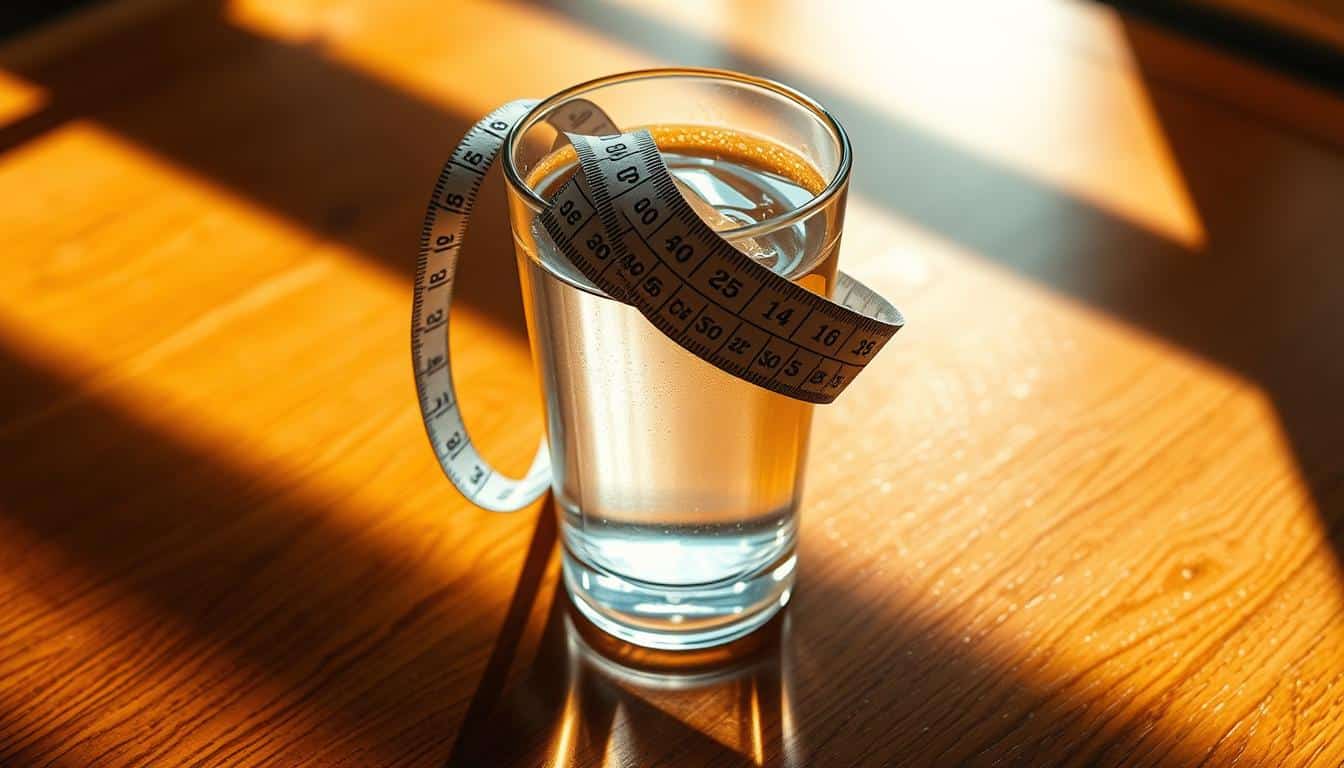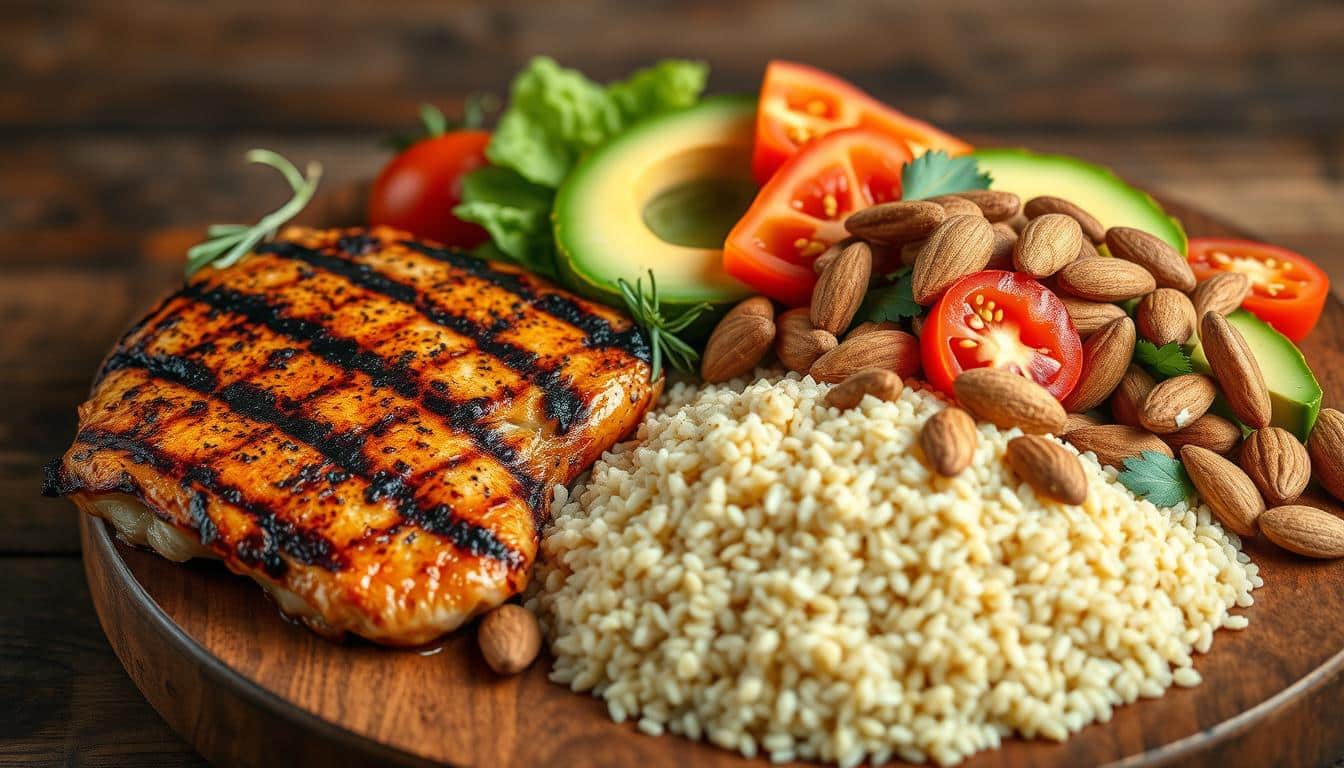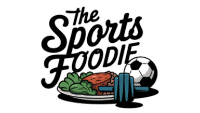Surprising fact: adding just 15% more calories than your maintenance can change your body composition in weeks, not months.
I’ve seen athletes gain steady strength with small, consistent increases. You track weight at least three times per week, find maintenance, then add about 15–20% calories. This keeps gains clean and limits excess fat.
This short guide shows simple steps to build muscle and improve strength. Follow whole foods, hit protein across every meal, and aim for 0.5–1% body weight gain per week. Drink 1.5–2 liters of water per day.
You’ll get a clear day example with eggs, chicken, rice, and veggies. The goal is steady muscle growth with six to eight small meals so you meet calories without discomfort.
Bottom line: add a modest calorie surplus, track progress, eat real foods, and you’ll make steady gains with less guesswork.
Set your calorie intake and weight gain target
Start by finding your true maintenance calories; that number guides every choice.
Weigh yourself at least three times each week and log what you eat. If your weight stays flat over a full week, that is maintenance.
Once you have maintenance, add a 15–20% calorie surplus to begin bulking. Example: 3,000 calories → about 3,450 calories.

Targets and adjustments
Aim to gain 0.25–1% of your body weight per week. This range limits body fat while you add mass.
If you gain faster than that, reduce calories slightly. If you don’t gain in a week, add 100–200 calories and recheck next week.
| Action | Example | Check |
|---|---|---|
| Find maintenance | Track weight & intake 1 week | Weight stable |
| Add surplus | +15–20% calories (~+450–500 kcal) | Monitor weekly |
| Adjust monthly | Recalculate as weight changes | Keep protein steady |
- Keep a log for calories, weight, and training.
- Keep protein steady while you adjust intake to protect mass.
- Use a daily plan you can follow so progress stays consistent and low stress.
Build your macros: protein, carbs, and fats for mass
Start with clear macro targets and you’ll remove guesswork from your gains.
Set protein at 0.7–1.0 grams per pound of body weight each day. This protects and helps build muscle mass. Put protein in every meal.
Aim for carbs at 55–60% of total calories. Choose whole grains and fruit so energy stays steady during long training sessions.
Keep fat at 15–20% of calories. Prioritize olive oil, nuts, and avocado to support hormones and joints.

- Protein: 0.7–1 g/lb per day to support muscle.
- Carbs: 55–60% of calories to fuel training and recovery.
- Fat: 15–20% of calories for health and calorie density.
- Remember: protein and carbs = 4 calories/gram; fat = 9 calories/gram.
| Macro | Range | Tip |
|---|---|---|
| Protein | 0.7–1.0 g per lb | Distribute across all meals |
| Carbs | 55–60% of calories | Pick whole grains and fruit |
| Fat | 15–20% of calories | Use olive oil, nuts, avocado |
Recheck these ratios when your calorie intake changes. Keep the numbers simple and repeat meals you like so the diet is easy to follow during a bulk.
bulking meal plan for athletes: foods to prioritize
Choose whole, nutrient-dense foods that make hitting calories simple and repeatable.
Pick proteins first. Chicken breast, beef, fish, eggs, dairy, and beans give you reliable protein each day.
Build carbs around rice, potatoes, oats, quinoa, pasta, and whole-grain bread. Brown rice and oats are great outside post-workout.
Healthy fats and extras
- Use olive oil, avocado, nuts, and peanut butter to raise calories fast.
- Keep butter small; prefer healthy fats for long-term recovery and joint health.
Produce and hydration
Load plates with spinach, broccoli, peppers, and berries for vitamins and fiber.
Drink about 1.5–2 liters of water per day. Front-load fluids before training to help energy and focus.
| Category | Examples | Use |
|---|---|---|
| Protein | Chicken breast, beef, fish, eggs, beans | Main plate item, spread through the day |
| Carbs | Rice, potatoes, oats, quinoa, pasta | Fuel training and recovery |
| Fats & extras | Olive oil, avocado, nuts, peanut butter | Raise calories with minimal volume |
Repeat balanced plates like beef or fish with rice and veggies. Rotate proteins and carbs across the week so your diet stays flexible and easy to follow.
Foods and habits to limit for clean bulking
Avoiding a few common triggers will protect your lifts and limit unwanted body fat.
Keep this list short and act on it this week. Small changes keep your diet predictable and your progress steady.
- Limit alcohol. It slows muscle gain and increases body fat.
- Cut added sugars in sodas, candy, and desserts. They add calories with no nutrients.
- Avoid deep-fried foods most of the week to lower inflammation and bloating.
- Skip very high-fat meals before training; they slow digestion and can cause cramps.
- Keep very high-fiber dishes away from pre-workout sessions to avoid stomach upset.
- Don’t drink carbonated beverages before lifts; gas can disrupt breathing and core bracing.
- Watch sauces and butter; they hide big calories that derail a strict diet.
- If your weight jumps too fast in one week, tighten snacks and cut empty calories first.
| Issue | Why it matters | Quick swap |
|---|---|---|
| Alcohol | Hurts recovery; raises body fat | Limit to 0–1 drinks on low-training days |
| Added sugars | Empty calories; poor nutrients | Choose fruit, yogurt, or milk |
| Pre-workout triggers | High fat/fiber or fizz cause cramps | Have plain carbs and protein 60–90 min before |
| Hidden fats (butter, sauces) | Quickly inflate calories | Measure or skip; use olive oil sparingly |
Plan meals that digest well around training. Do this and your body will use more of the added calories for muscle, not fat. Keep it simple and consistent during your bulking phase.
Meal frequency and timing per day
Eat six meals per day to hit your calorie needs without feeling stuffed.
Space feedings every 2–4 hours. This keeps energy steady and aids recovery.
- Put protein in every meal to build muscle and protect body mass.
- Use more carbs before and after training. Fast carbs post-workout boost protein synthesis.
- Keep fat lower after training so carbs and protein digest quickly.
- Add a casein shake or yogurt at night to limit overnight breakdown.
Carry a ready protein drink and a carb snack. Don’t skip a feeding window.
| Timing | Goal | Example |
|---|---|---|
| Morning | Energy + protein | Oats + eggs |
| Pre-workout | Fuel strength | Rice + lean protein |
| Post-workout | Restore carbs & protein | Whey + banana |
| Night | Prevent overnight fat loss | Casein or cottage cheese |
Keep a simple, repeatable plan. Review your schedule weekly and lock in times that match your training and life.
Sample day: high-calorie clean bulk meals
This example day shows clear portions and pairings to hit your calorie targets.
Breakfast
6-egg omelet with a handful of spinach. Add 1 cup oats with yogurt and fruit on the side.
Mid-morning
Sip a protein shake. Add a banana or a scoop of mass gainer if you need more calories.
Lunch
Grilled chicken breast with brown rice and mixed peppers. Top rice with a drizzle of olive oil to raise calories.
Pre / Post-workout
Pre: a small portion of rice or fruit. Post: mix whey protein powder with milk or water for quick recovery.
Dinner
Rotate salmon or beef with sweet potatoes or white rice and a big serving of greens.
Snacks
Mixed nuts, cottage cheese, jerky, or a spoon of peanut butter on toast. These fill gaps without heavy prep.
- Hydrate across the day; small sips between feeds work best.
- Rotate fish, chicken, and beef each week to keep food interesting.
| Time | Food | Portion / approx calories |
|---|---|---|
| Breakfast | 6 eggs, oats, spinach | 700–800 kcal |
| Lunch | Chicken breast + brown rice + veggies | 600–750 kcal |
| Post-workout | Whey protein powder + milk | 200–300 kcal |
| Dinner | Salmon or beef + potatoes + greens | 600–800 kcal |
Weekly meal plan framework for strength and mass
Make one clear plate rule and use it across seven days to simplify eating.
Pick a structure you can repeat: protein + carb + veggie + healthy fat. Do this every meal and the math gets easy.
Rotate proteins
Use chicken, fish, beef, turkey, eggs, or beans on different days. Rotate so muscle gets varied nutrients and you don’t get bored.
Rotate carbs
Choose white rice, brown rice, quinoa, pasta, or potatoes. Match higher-carb days to your hardest training sessions to drive mass and recovery.
Build plates
- One protein per plate (chicken, fish, beef, turkey, eggs, beans).
- One carb per plate (rice, brown rice, quinoa, pasta, potatoes).
- Add a veggie and a healthy fat like olive oil, avocado, or nuts.
- Batch-cook staples on Sunday so weekday meals are fast.
| Element | Example | Use |
|---|---|---|
| Protein | Chicken / Fish / Beef | Main source of muscle building |
| Carb | White rice / Brown rice / Potatoes | Fuel training & mass |
| Veg + Fat | Spinach, broccoli + Olive oil, avocado | Recovery, digestion, calories |
Keep this plan simple, log progress, and tweak portions each week based on your weight and performance. Consistency builds muscle growth.
Smart supplements that fit the plan
Use supplements to support consistent progress, not replace good food.
Whey protein and casein for convenient protein
Whey protein is an easy way to raise daily protein when time is tight or appetite is low.
Casein at night gives slow-release protein while you sleep. Both help you build muscle when used with real food.
Creatine monohydrate to boost strength and volume
Creatine supports short bursts of high-intensity work and increases training volume.
Take 3–5 g daily. You can load first or skip loading. Mix it into a shake or juice for consistency.
Caffeine for focus — use with care
Caffeine reduces fatigue and sharpens focus pre-workout. Keep doses modest to avoid jitters and sleep loss.
- Track total calories and intake so shakes don’t replace balanced plates.
- Watch recovery and adjust if you feel bloated or sleep worsens.
- Consult a clinician before starting supplements, especially if you take meds.
| Supplement | Purpose | Typical dose & timing |
|---|---|---|
| Whey protein / protein powder | Raise daily protein fast | 20–30 g after training or between meals |
| Casein | Nighttime protein to limit breakdown | 20–40 g before bed |
| Creatine monohydrate | Increase strength & training volume | 3–5 g daily, any time; add to shake |
| Caffeine | Improve focus and reduce fatigue | 100–200 mg pre-workout; avoid late evening |
Conclusion
Make a simple habit: set targets, track intake, and adjust monthly.
Start with a 15–20% calorie surplus and aim to gain 0.25–1% weight per week. Keep protein high and anchor each meal plan around protein, carbs, veggies, and healthy fats.
Drink water across the day. Use carbs before and after hard sessions. Pick whole foods you like — chicken, rice, and greens make consistency easy.
Use whey and creatine if you want extra support, but let real food drive most muscle growth. Check calories and weight per day and tweak portions per week.
Stay patient. Small, steady wins add up to lasting muscle growth.


